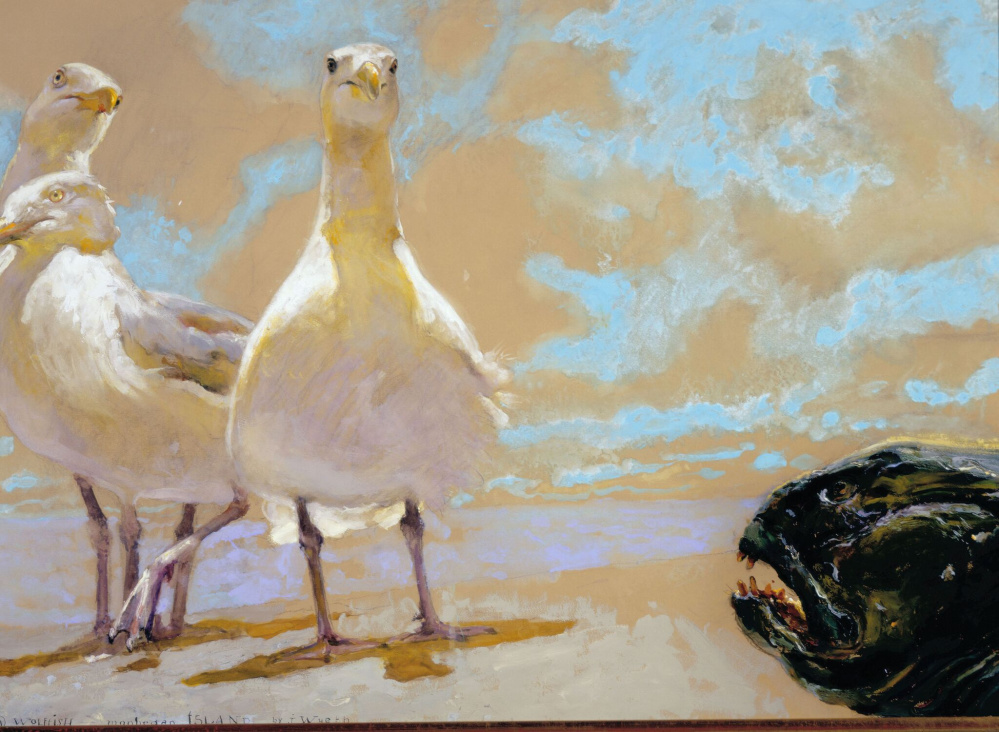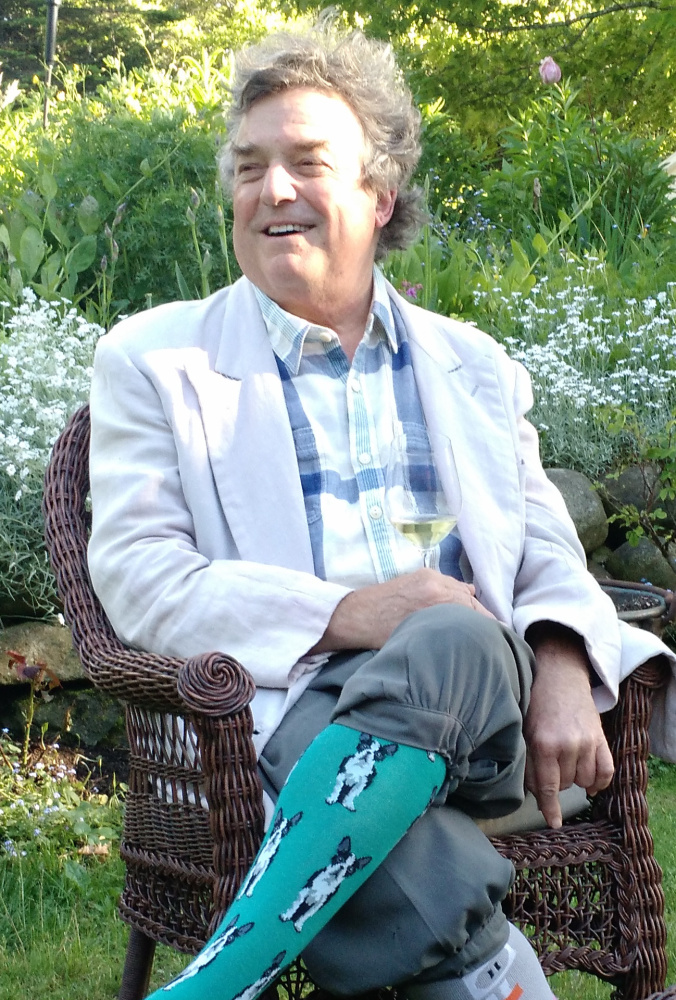TENANTS HARBOR — It’s the end of another long day of painting in isolation, and the artist is happy to have company. Jamie Wyeth bounds down the stairs of his Tenants Harbor home with the arrival of guests in his kitchen.
“Hello,” he calls from above, then enters the kitchen in a whirl of energy, wearing knickers and mismatched colorful leggings. His face is flushed red. “A drink,” he exclaims. It’s more a statement than a question. “Whiskey? Bourbon? Wine?”
A dinner date beckons in 90 minutes. Until then, there’s time for libations and conversation on the lawn. His guest, Ogunquit Museum of American Art interim director Andres Verzosa, opts for a glass of water. Wyeth pours a glass of something fizzy for Verzosa, then grabs a chilled bottle of white wine from the fridge and pours a glass for himself and other friends who are part of the gathering.
After briefly admiring Rockwell Kent’s 1907 oil painting of a Monhegan sunset that hangs in the home, they move into the sun-splashed garden, where they are joined by Wyeth’s faithful West Highland terrier, Iggy, who plops down on the grass and begins an outdoor slumber.
“Here’s to you,” Wyeth says, toasting Verzosa, who took over as interim director of the Ogunquit musuem on short notice in the spring.
Though it feels very social, this is a working meeting – and an unusual one at that. Studio visits between curators and artists are not unusual, but they are less common with an artist of Wyeth’s stature. Verzosa had never met Wyeth and wanted to chat him up before the museum opened its big summer exhibition of Wyeth’s paintings, called “Private Collection.” With Wyeth’s permission, Verzosa invited a reporter to tag along.
Wyeth and his wife, Phyllis, own nearly all the paintings in the exhibition. Those they do not own are part of the collection administered by Wyeth’s mother, Betsy, the widow of painter Andrew Wyeth, Jamie’s father.
Wyeth, who turns 70 on Wednesday, is one of the most famous painters in Maine, and he has been nearly all his life. Born to a legacy of American realism and illustration, the third-generation painter has carved his own painterly vision since the 1960s, moving successfully beyond the influence of his father and grandfather, N.C. Wyeth, to create a body of work that is rooted in realism but includes so much more. His work was the subject of a recent retrospective, organized by the Museum of Fine Arts in Boston.
The Ogunquit exhibition is small, only 18 paintings. They span Wyeth’s career, the earliest dating to 1961. Wyeth handpicked nearly all of them, and several are right off the walls of his home. Verzosa asked for this meeting so he could lead informed gallery talks with visitors – and also, perhaps, suggest a few changes to the roster of paintings.
Wyeth obliged. Anything Verzosa wanted, he got, including one of Wyeth’s most popular paintings, “Red House,” from Monhegan. It’s a watercolor from 1972 and depicts one of the island’s most recognized homes, because of its location on the harbor near the ferry landing.
Verzosa also requested a few recent paintings and drawings of Andy Warhol. Wyeth spent a lot of time with Warhol in the 1970s, and he kept a studio in Warhol’s Factory in New York. The Factory was the name of Warhol’s studio complex, and the site of legendary drug and sex parties.
Warhol has been a recurring theme in Wyeth’s paintings since the ’70s. The works chosen for the Ogunquit exhibition are loose portraits, mostly rough and unfinished, all from 2012.

“The Wolffish,” Jamie Wyeth, 2004, mixed media on hand-wove toned paper, 25 by 35 inches, courtesy Phyllis and Jamie Wyeth.
A finished painting, “Moonlight Voyeur,” also from 2012, shows Warhol on the rocks at Monhegan, hands together looking out over the water and lit by moonbeams from above. “He was a fascinating person, and very childlike,” Wyeth said of Warhol. “He always wanted to come to Maine and I always wanted to bring him to Maine, so I put him on the rocks of Monhegan.”
The talk of Monhegan leads to talk of Rockwell Kent, another man of mystery and Wyeth’s favorite artist. He owns many of Kent’s paintings, as well as the house that Kent built on Monhegan. He began buying Kent artwork in the 1960s as a teenager with financial means. While browsing a New York bookshop, he found a Kent drawing from his “Moby-Dick” series, which was used to illustrate a popular edition of the book published in 1930. “Is this original? Do you have more?” Wyeth asked.
Yes and yes, the store’s owner replied. Wyeth bought the complete set.
He’s been enamored of Kent since and corresponded with him by letter just before he died, and soon after Wyeth purchased Kent’s house on Monhegan. He considers Kent the most maligned American artist in history, because of the fallout from his political and pro-Soviet stances. Kent sued the U.S. government when his passport was revoked, winning the right to travel to the Soviet Union in 1958. After a successful Moscow exhibition, Kent donated hundreds paintings to the USSR. Wyeth has lectured about Kent in the Soviet Union, and remains firm in his belief that the artist is under-appreciated in his native United States.
“His greatest works are in Russia,” Wyeth says during his garden talk. “He’s been totally forgotten. I bought his house and collect his work, but the political thing killed him.”
UP TO DATE ON MAINE ART
Wyeth is eager to talk about art in Maine. He’s well-versed in contemporary Maine painting and knows the work of many Maine artists through their New York dealers. This meeting occurred in early June, before the new Center for Maine Contemporary Art opened in Rockland. Wyeth hadn’t seen the new building yet but was making plans to do so. He marveled at the changes in Rockland.
“When I grew up it was all fish factories, and now there are two museums downtown,” he says. “I can’t believe it.”
He then mentions Henry Strater, who founded the Ogunquit museum in 1953. Strater was a successful painter, who came to Ogunquit to study with Hamilton Easter Field in 1919 and built a home there a few years later. Andrew Wyeth knew Strater. “I just know him from my father, who told me stories,” Jamie Wyeth says. “He told me that Strater met Hemingway in Paris and painted his portrait. That’s the most interesting thing of his I’ve seen.”
“And we have it up,” Verzosa says, urging Wyeth to attend the opening so he can see the Hemingway portrait again. Wyeth is non-committal. Verzosa assures him he will hold a hotel room.

“Sea Watchers (Study),” 2009, gouache, gesso, and watercolor on gray archival cardboard, 24” x 53”, courtesy Phyllis & Jamie Wyeth
They soon discover they have Maine sculptor Bernard Langlais in common. Verzosa actively worked to conserve Langlais’ wooden sculptures and sold many of Langlais’ pieces when he operated a Portland gallery. The Ogunquit Museum owns several, which are on permanent view in the outdoor sculpture garden.
Langlais lived and worked in Cushing on a peninsula long associated with the Wyeths and their paintings. “I knew Blackie as a child,” Wyeth said, invoking Langlais’ nickname. “He lived down the road from where I grew up.”
His father “loved” the Langlais sculpture “Local Girl,” which spoofed Andrew Wyeth’s “Christina’s World,” Wyeth’s most famous painting and one of the most recognized works in American art. Completed in 1948, it shows local girl Christina Olson crawling through the field to her distant home. Olson’s home, now operated as a historic site by the Farnsworth Art Museum, is on the Cushing peninsula, just down the road from the Langlais estate and near where Andrew Wyeth lived and worked.
It’s a poignant painting, because it dramatically illustrates how Olson copes with a disease that leaves her unable to walk. She pulls herself through the tall grass to her home. Langlais prominently displayed “Local Girl” in his yard, a big wooden human form, her body twisting through the fields. It was his little joke for the tourists driving down the peninsula in search of the house in the famous paintings.
His father always found it amusing, Wyeth said.
After Olson died, Wyeth shifted his focus to another local girl, Siri Erickson, who also lived just a few doors down from Langlais. Andrew Wyeth started painting Siri when she was 14, and he often painted her nude. That created a local scandal that lingered for years, until Betsy Wyeth urged her husband to stop. “I’m not even sure if Blackie was aware all that going on just down the road,” Wyeth says with a small chuckle.
As the conversation winds down, Verzosa notes the presence of fresh paint on Wyeth’s fingers, and asks if he has been painting.
“It’s all I do,” Wyeth responds. “It’s who I am. I’m actually kind of boring. I don’t travel much. I don’t play tennis. I paint.”
Send questions/comments to the editors.





Success. Please wait for the page to reload. If the page does not reload within 5 seconds, please refresh the page.
Enter your email and password to access comments.
Hi, to comment on stories you must . This profile is in addition to your subscription and website login.
Already have a commenting profile? .
Invalid username/password.
Please check your email to confirm and complete your registration.
Only subscribers are eligible to post comments. Please subscribe or login first for digital access. Here’s why.
Use the form below to reset your password. When you've submitted your account email, we will send an email with a reset code.